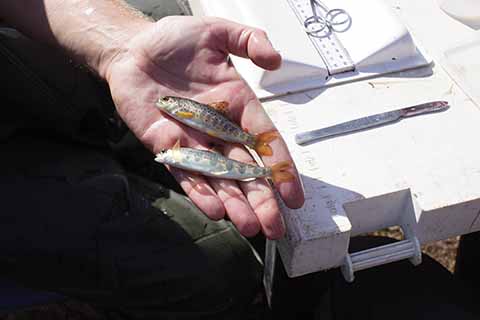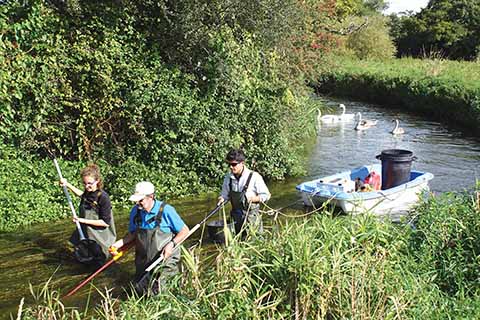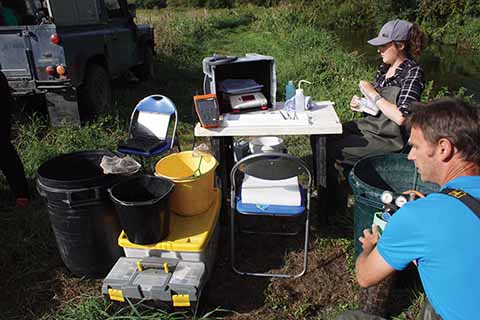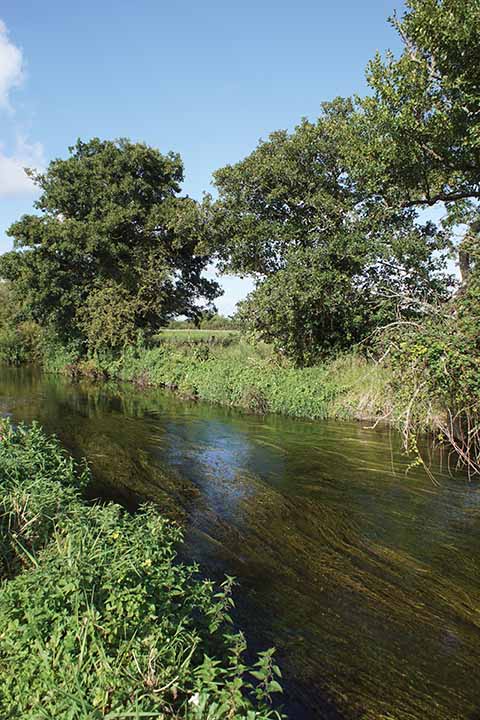Salmon tagging on the Frome
Joël Lacey spent a day with a group of scientists who are finding out more and more about Dorset's chalk stream visitors
Published in June ’19
It’s mid-morning on a bright and warm late summer’s day. As a pair of swans and their three near fully grown cygnets move serenely and effortlessly out of the way, three people are wading along the shallow waters of the River Frome at Lower Bockhampton.
The hindmost of the three is towing a small boat with both a large plastic bin full of river water and a generator on it, the latter chugging unhurriedly. One of the other two waders, who are walking abreast, carries a small fishing net and a black plastic bucket. The other has a net too and is also holding what looks like a metal detector with its tip under the water’s surface.
This is in fact one of two electrodes attached to the generator and he is gently electrifying the river, with a view to temporarily befuddling any juvenile salmon and trout within. The fish are merely dazed for a matter of seconds so quick reactions are vital for capturing the fish in order for them to be measured and tagged. Where the fish rise, they are quickly netted and put in the bucket until that is transferred to the bin. After a spell of electrofishing, the bin is transferred to a riverside mobile laboratory.
The fish are first transferred to another bin with a mild sedative to keep them calm. They are then weighed and their length measured and recorded on a database. The fish are then tagged using small (12x2mm) passive integrated transponder (PIT) tags. The tag’s unique signature goes into the database with the corresponding fish’s physical details.
As well as the weight and size being taken, a few scales are scraped off for laboratory analysis. The scales can give information about the sex, age and development of the juvenile fish. An unused (adipose) fin is marked so adult fish can be instantly identified as having been tagged, then the fish are quickly moved to another bin with extra-oxygenated river water to fully awaken them. When a batch is done, all the fish are gently returned to the same stretch of river from which they were taken.
Salmon will have come out of the eggs in late March or early April, they’re five to six months old when they are tagged. Salmon are called parr at this age and most of them will age for another six months then, come spring, they’ll go off to sea.
Depending on where they have grown up, the passage of tagged fish out to sea is recorded by smolt counters at the main river weir at East Stoke, the Tadnoll Brook tributary and the Environment Agency fish pass at Loud’s Mill, Dorchester.
Salmon grow very quickly in the Frome’s highly productive environment and 97 per cent will go off to sea aged one. Only five per cent, though, will survive to return to spawn.

A salmon parr and trout for comparison. The slightly bigger fish is the trout, most easily recognised by its larger mouth.
Some salmon, though, stay longer; they’re unusual and they are known as precocious fish. These tend to be male and effectively they cheat; they mature in the river – without going to sea and undergoing all the difficulties and stress out there – and they have a go at spawning. Unlike Pacific salmon, it’s not instant death for every spawning fish in the Frome. Some fourteen or fifteen per cent will go back to sea and make a second return journey to their birthplace to have a second go at spawning.
The River Frome was chosen as a site by the Freshwater Biological Association when it set up at East Stoke in 1929 to facilitate the science of all things fish. In the 1970s, people were exploring ways of assessing salmon stock, and the idea of a restivity counter (the counter that counts the adults coming up) went in and it’s been there ever since. It’s an incomparable site in terms of the data that’s been collected, so it made sense for the Frome to be a tagging site. The Frome is atypical of many salmon rivers as it is a chalk stream. It’s not unique – there are the Hampshire Avon and the River Test, but otherwise it’s unusual for Atlantic salmon breeding rivers to be aquifer-fed, not rain fed.
Some of the resident brown trout that are also tagged in the scheme will, like the salmon, make their way out to sea to fatten up and become migratory sea trout. Since 2014 the scientists have tagged trout to try to find out why some do go to sea and some stay.
Every September since 2006, the Game and Wildlife Conservation Trust’s fisheries team catch, weigh, measure, sample and tag more than 10,000 salmon parrs. Their tagging of a significant proportion of the autumn parr population is a key component of the trust’s ability to both monitor the movements and estimate the numbers of survival of parrs, smolts and adult marine fish.
Orvis UK is helping the Frome Project by providing funding towards the electrofishing equipment and to pay for the tags which are essential to the project and future monitoring of the salmon parr that it catches each year.
By being able to monitor the movements and survival of young salmon in the River Frome and to estimate the numbers of year-old salmon (smolts) that leave the river each spring and comparing the data with the levels of survival of the fish that return to the river as adults, the trust can continue to build a picture of the health of the Frome’s salmon population in particular and the health of the Atlantic salmon species as a whole.
This information is in turn reported to the UK government through the Environment Agency and the Centre for Environment, Fisheries and Aquaculture Science (CEFAS) and then to the ICES (International Council for the Exploration of the Sea) Atlantic Salmon working group and the North Atlantic Salmon Conservation Organization (NASCO) in Europe.
The 10,000 individual parrs that are tagged throughout the river’s catchment represents an astonishing 15-20% of the total salmon in the River Frome.

After they have been returned to their re-invigorated selves, the tagged fish are released back into the river, in the spot from where they were taken
One tagged parr from the Frome was recorded swimming past the GWCT detection equipment on the night of 24 April 2008 on its way out to sea when it was estimated to be approximately 14.9cm long. On 6 October 2009, the same fish was picked up during a sampling programme organised by NASCO in Sisimiut on the west coast of Greenland, by which time it had grown to 67.9cm (just over 2¼ feet) in length. A growth rate of a millimetre a day for 530 days.
As the scientists pack up their mobile lab, the fish return to their feeding – a constant effort so they too can get big enough and strong enough to hazard thousands of miles of sea travel before returning one day to their home waters to be responsible for creating the next generation of Frome Atlantic salmon. And the swans sail serenely by.




